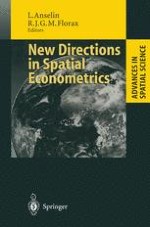1995 | OriginalPaper | Buchkapitel
Bayesian Hierarchical Forecasts for Dynamic Systems: Case Study on Backcasting School District Income Tax Revenues
verfasst von : George T. Duncan, Wilpen Gorr, Janusz Szczypula
Erschienen in: New Directions in Spatial Econometrics
Verlag: Springer Berlin Heidelberg
Enthalten in: Professional Book Archive
Aktivieren Sie unsere intelligente Suche, um passende Fachinhalte oder Patente zu finden.
Wählen Sie Textabschnitte aus um mit Künstlicher Intelligenz passenden Patente zu finden. powered by
Markieren Sie Textabschnitte, um KI-gestützt weitere passende Inhalte zu finden. powered by
Time series forecasting for relatedunits is common practice. Examples include sales of a chain of fast-food restaurants in a metropolitan area, precipitation in neighboring sections of farm land, and, as explored in this chapter, tax revenues for the school districts of a county. Our premise is that there is information in the cross- sectional data to be exploited for forecasting. The geographic scale of our research is much smaller and therefore our data are more dynamic than those of related studies. Garcia-Ferrer et al. (1987) and Zellner and Hong (1989) used Bayesian shrinkage methods for pooling time series forecasts — similar to the one we develop in this chapter — to forecast growth in the economies of several countries. Lesage and Magura (1990) applied the same and additional methods to multi-regional data, seven metropolitan areas in Ohio. Our interest is in small local government economies at the subregional level. We forecast (and backcast) income tax revenues for forty school districts in Allegheny County, Pennsylvania.
